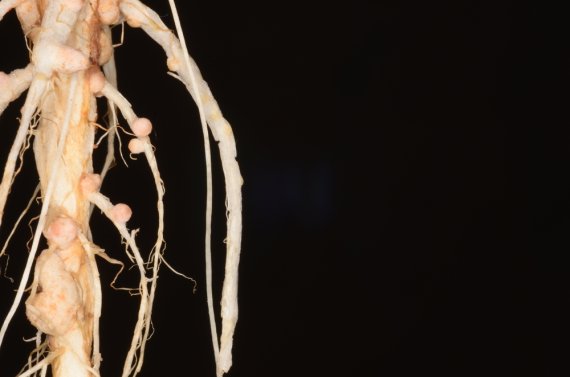Nitrogen fixing on the roots of plants. The bacteria live on the plant’s roots, where they form tubers called root nodules. @Shutterstock
In the symbiosis between legumes and rhizobium bacteria, the plants produce carbon for the bacteria which in return produce nitrogen for the plant. In doing so, the bacteria offer a ‘natural fertiliser’ to legumes such as soy and peas. After a DNA analysis of over thirty plants species, the group discovered that many plant varieties have lost this symbiosis with the bacterium.
‘For many years, we thought that nitrogen-fixing symbiosis had developed several times across various plant lineages’, says Wageningen researchers Wouter Kohlen. ‘Based on DNA analyses, we now suspect this symbiosis was widespread and most probably only arose once. However, with time, many plant species lost this property.’
Fertiliser
If we understand the evolution of nitrogen fixing, we could explore how to introduce nitrogen fixing in other species than legumes, says Kohlen. Nitrogen fixing has been considered one of the holy grails of plant sciences for decades. If we would be able to introduce nitrogen fixing in crops such as rice and wheat, we could greatly improve food security with less fertiliser in large parts of the world.
Parasponia
Wageningen researchers came to a similar understanding in a recently published article in PNAS. They compared the genome of the Parasponia tree, which fixes nitrogen, to the closely related species of the genus Trema, which do not. They found that plant genes that are important for the symbiosis, such as the NIN-gen, have been lost independently from the genomes of the Trema lineages. This suggests that Trema has lost the nitrogen-fixing symbiosis.
Two genes
The results of the research were published in Science on 25 May. In this research, the researchers performed a comprehensive analysis by comparing several nitrogen-fixing plants to closely related species that cannot fix nitrogen. An international group of researchers, of which Kohlen was part, compared thirty-seven plant species with and without symbiosis and concluded that the plants without nitrogen fixing have lost at least two genes throughout evolution.
Kohlen: ‘We suspect that only a handful of genes are used exclusively for nitrogen fixing. But these genes likely work together with other genes that are still present in the plants. Evolution teaches us what we should do to make these plants symbiotic.’

